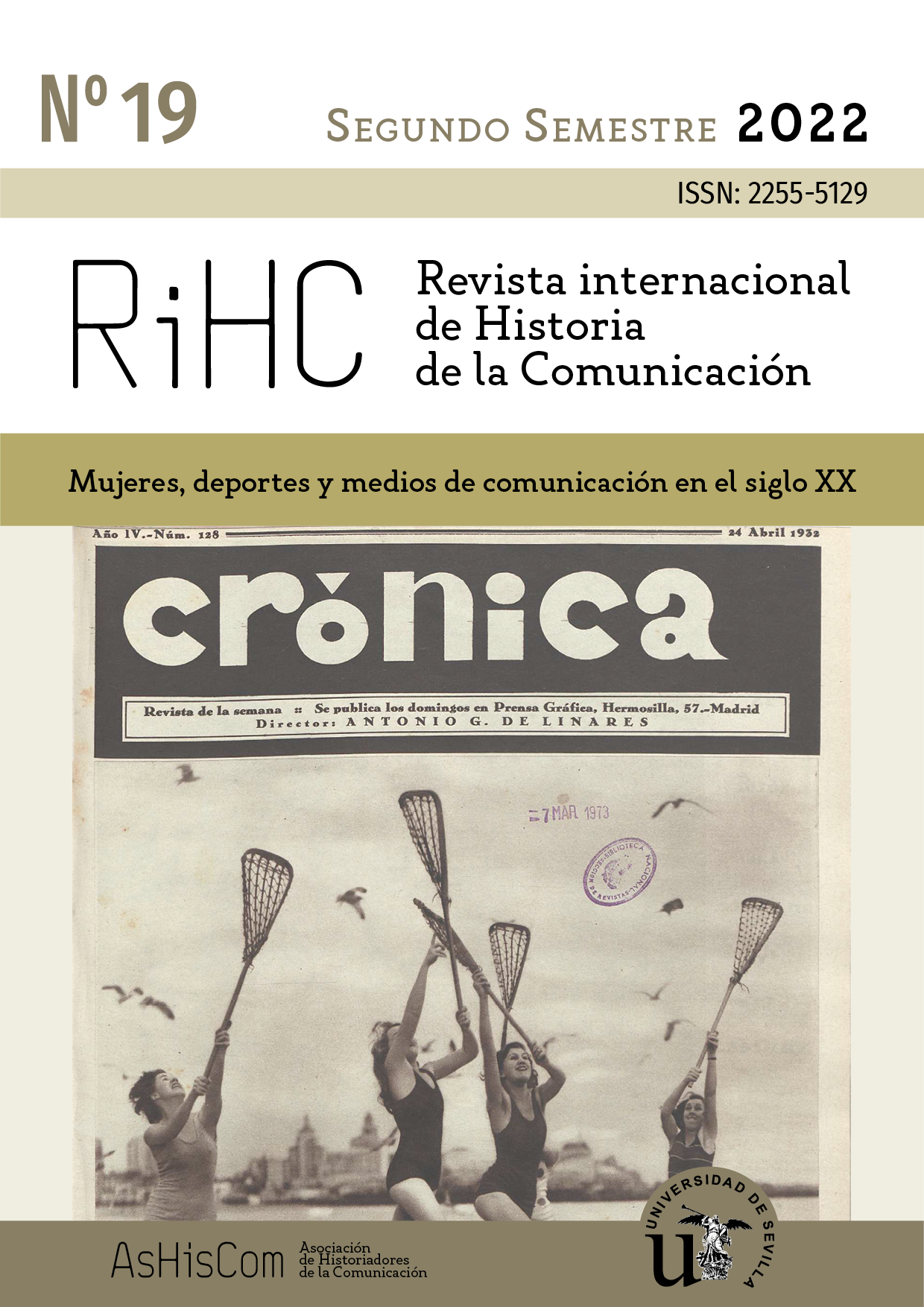Influencias del periodismo interpretativo en la interpretación del patrimonio de Freeman Tilden
DOI:
https://doi.org/10.12795/RiHC.2022.i19.11Palabras clave:
Periodismo, interpretación del patrimonio, géneros interpretativos, Freeman TildenResumen
En 1957, el periodista estadounidense Freeman Tilden publicó su libro titulado Interpreting Our Heritage. Con el paso de los años, esta obra se convirtió en un referente para una nueva disciplina académica y profesional por lo que se considera la base teórica de la interpretación del patrimonio. Sus propuestas para comunicar al público los valores históricos y naturales de manera eficaz se enmarcan en un contexto sociocultural caracterizado por importantes cambios en la prensa debido a que los periodistas pasaron de la redacción de noticias a escribir el porqué de los hechos, sus causas y las consecuencias. Este artículo sugiere que esta nueva fórmula, propia del llamado periodismo interpretativo, presenta un paralelismo con las propuestas de Tilden y destaca la correspondencia entre ambas estrategias en un marco sociocultural común que pudo haber generado e inspirado las bases para la interpretación del patrimonio.
Descargas
Citas
ALADRO, E. (1995). Periodismo de Investigación: Historia, teoría y metodología. En EL-MIR, A.J., y VALBUENA, F. (comps.). Manual de periodismo (pp. 111-132). Universidad de Las Palmas de Gran Canaria.
ARROYO, M. (2006). El consumo de revistas juveniles entre los menores. En FUNDACIÓN COSO (ed.) La ética y el derecho en la producción y el consumo del entretenimiento (pp. 111-121). Fundación COSO de la Comunidad Valenciana para el Desarrollo de la Comunicación y la Sociedad.
BAZÁN, H. (2014). La Interpretación del Patrimonio Geomorfológico en los Picos de Europa: una propuesta para su aprovechamiento didáctico y geoturístico. Tesis Doctoral: Universidad de Valladolid.
BENAVIDES, J.L. y QUINTERO, C. (2004). Escribir en prensa. Editorial Pearson.
CANO, R. (20 de diciembre de 2017). “Filosofía de la interpretación”. [Mensaje en un blog] EVE Museología+Museografía. Recuperado de https://evemuseografia.com/2017/12/20/filosofia-de-la-interpretacion/
CASALS, M.J. (2005). Periodismo y sentido de la realidad. Teoría y análisis de la narrativa periodística. Fragua.
COPPLE, N. (1968). Un nuevo concepto del periodismo: reportajes interpretativos. Pax-México.
CHILLON, A. (1994). L'estudi de les relacions entre Periodisme i Literatura per mitjá del Comparatisme Periodístico-Literari. Anàlisi: quaderns de comunicació i cultura, 16, pp. 123-150.
— (1999). Periodismo y literatura: una tradición de relaciones promiscuas. Universitat Autónoma de Barcelona.
— (2009). New New Journalism: Vell Periodisme Nou. Capçalera, 1, Núm. 144, https://raco.cat/index.php/Capcalera/article/view/324764
CHIVELET, M. (2011). El diseño de revistas para los niños, exponente de su evolución en el entorno social. En PÉREZ CUADRADO, P., y PUEBLA MARTÍNEZ, B. (coords.) Revistas versus magazines (pp. 65-74). Universidad Rey Juan Carlos.
DE DIEGO, A. (2015). Periodismo escrito (II). Los géneros interpretativos. Ediciones CEF.
FAGOAGA, C. (1982). Periodismo interpretativo: el análisis de la noticia. Editorial Mitre.
FERNÁNDEZ-CHAPOU, M.C. (2004). Las letras del nuevo periodismo: Una corriente que abreva de la literatura con una actitud innovadora. Revista Mexicana de Comunicación, 88 (16), pp. 18-23.
FLICK, U. (2015). Introducción a la investigación cualitativa. Ediciones Morata.
FRÍAS, C., & MOYA, J. A. (2005). La almadraba: una pesquería milenaria a través del documental. En SÁNCHEZ FERNÁNDEZ, M.J., FRÍAS, C., SÁNCHEZ FERNÁNDEZ, A., y MOLINA, J. (coords.). III Congreso Internacional de Estudios Históricos: El Mediterráneo: la cultura del mar y la sal (pp. 167-182). Ayuntamiento de Santa Pola.
GARBISU, M. (2015). Literatura y creación literaria. Ediciones CEF.
GOMIS, L. (1991). Teoría del periodismo: cómo se forma el presente. Paidós Comunicación.
GONZÁLEZ, I., BRIZUELA, L., & GONZÁLEZ, G. (2008). Tocar el fondo a un chasquido de dedos. Aproximaciones a las características del estilo interpretativo en las agencias de noticias. Estudios sobre el Mensaje Periodístico, 14, pp. 419-433.
GONZÁLEZ REYNA, S. (1991). Géneros periodísticos 1. Periodismo de opinión y discurso. Editorial Trillas.
GRIJELMO, Á. (1997). El estilo del periodista. Taurus.
GUERRA, F. (1998). La interpretación: una herramienta para conocer el Patrimonio. Andalucía Ecológica, Año I. Núm. 2, pp. 32-33.
KAPUSCINSKI, R. (2003). Los cínicos no sirven para este oficio. Anagrama.
LÓPEZ-HIDALGO, A. (2002). Géneros periodísticos complementarios: una aproximación crítica a los formatos del periodismo visual. Comunicación Social.
— (2003). El análisis: ¿un género periodístico? Ámbitos. Revista Internacional de Comunicación, 9-10, pp. 209-223. https://doi.org/10.12795/Ambitos.2003.i09-10.11
LÓPEZ, L., y BORDA I. (2015). La prensa infantil y juvenil como fenómeno educativo en España. Estudios sobre el Mensaje Periodístico, 2 (21), pp. 1081-1097.
LÓPEZ-PAN, F. (2000). Albert CHILLÓN. Periodismo y literatura. Una tradición de relaciones promiscuas. Universidad Autónoma de Barcelona.
LORENCI, M. (3 de diciembre de 2012). “’Gente Menuda', un repaso a los pioneros de la línea clara”. ABC. Disponible en: https://www.abc.es/cultura/rc-gente-menuda-repaso-pioneros-201212030000_noticia.html#vca=rrss&vmc=abc-es&vso=mail&vli=cm-general
MACKINTOSH, B. (1986). Interpretation in the National Park Service: a historical perspective. History Division. NPS. Department of the Interior. https://www.nps.gov/parkhistory/online_books/mackintosh2/origins_before_nps.htm
MARTÍNEZ-ALBERTOS, J.L. (1974). Redacción periodística: los estilos y géneros en la prensa escrita. A.T.E.
MARTÍNEZ-ALBERTOS, J.L. y SANTAMARÍA, L. (1996). Manual de estilo. Instituto de Prensa de la Sociedad Interamericana de Prensa.
MARTÍNEZ-VALLVEY, F. (2018). Teoría del periodismo. Centro de Estudios Financieros.
MEJÍA-CHIANG, C. (2010). Devenir de los géneros interpretativos en la prensa generalista. Estudio de las secciones “Internacional” y “España” del diario El País. Editorial Fragua.
MÉNDEZ, S. (2013). Fuentes clásicas sobre la phantasía en el De sculptura de Pomponio Gaurico. Humanitas, 65, pp. 141-159. http://dx.doi.org/10.14195/2183-1718_65_8
MORALES, J. (2001). Guía Práctica para la Interpretación del Patrimonio: El arte de acercar el legado natural y cultural al público visitante. Consejería de Cultura. Junta de Andalucía.
NÚÑEZ-LADEVÉZE, L. (1995). Introducción al periodismo escrito. Editorial Ariel.
SANMARTÍ, J.M. (2004). Más allá de la noticia: el periodismo interpretativo. CANTAVELLA, J., y SERRANO, J.F. (coords.). Redacción para periodistas: informar e interpretar (pp. 333-359). Ariel Comunicación.
SANTIBÁÑEZ, A. (1995). Periodismo interpretativo. Editorial Andres Bello.
TILDEN, F. (1957). Interpreting our heritage: Principles and practices for visitor services in parks, museums, and historic places. University of North Carolina Press.
— (2006). La interpretación de nuestro patrimonio. Asociación para la Interpretación del Patrimonio.
TIJERAS, R. (2013). Periodismo narrativo y no ficción. Comunicación 21, 3.
TORRES, M.A. (2012). El diseño de la comunicación del patrimonio cultural. Tesis de maestría: Universidad de Palermo (Argentina).
PARRATT, S. (2015). Los géneros periodísticos en la didáctica del periodismo en España. Un recorrido histórico/Journalistic genres in teaching of journalism in Spain. A historical review. Historia y Comunicación Social, 1 (20), pp. 17-26.
RANDALL, D. (1999). El periodista universal. Siglo Veintiuno de España Editores.
VILLACÍS, R. (1997). Manual de periodismo cultural. Colegio de Periodistas de Pichincha.
YANES, R. (2006). La crónica, un género del periodismo literario equidistante entre la información y la interpretación. Especulo. Revista de Estudios Literarios, 32, pp. 1-9.
Descargas
Publicado
Cómo citar
Número
Sección
Licencia
Derechos de autor 2022 RIHC. Revista Internacional de Historia de la Comunicación

Esta obra está bajo una licencia internacional Creative Commons Atribución-NoComercial-CompartirIgual 4.0.
RiHC. Revista internacional de Historia de la Comunicación es una publicación de acceso libre, ofrece su contenido bajo el principio de que hacer disponible gratuitamente la investigación al publico apoya a un mayor intercambio de conocimiento global.
RIHC. Revista internacional de Historia de la Comunicación se adhiere a las diferentes iniciativas que promueven el acceso libre al conocimiento, por lo que todos los contenidos son de acceso libre y gratuito y se publican bajo licencia de Creative Commons Reconocimiento-NoComercial 4.0 Internacional.

En virtud de ello, los autores que publiquen en esta revista aceptan las siguientes condiciones:
Los autores conservan los derechos de autor y ceden a la revista el derecho de la primera publicación, con el trabajo registrado con la licencia de atribución de Creative Commons, que permite a terceros utilizar lo publicado siempre que mencionen la autoría del trabajo y a la primera publicación en esta revista.
Los autores pueden realizar otros acuerdos contractuales independientes y adicionales para la distribución no exclusiva de la versión del artículo publicado en esta revista (p. ej., incluirlo en un repositorio institucional o publicarlo en un libro) siempre que indiquen claramente que el trabajo se publicó por primera vez en esta revista.
Se permite y recomienda a los autores publicar su trabajo en Internet (por ejemplo en páginas institucionales o personales) ya que puede conducir a intercambios productivos y a una mayor y más rápida difusión del trabajo publicado (vea The Effect of Open Access).
No prevé moving wall o período de embargo
Debe utilizarse la versión de editor/PDF
La fuente editorial debe reconocerse



